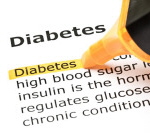
A • B • C • D • E • F • G • H • I • J • K
L • M • N • O • P • Q • R • S • T
U • V • W • X • Y • Z
Medical Tests
Definitions
Dawn Phenomenon: Â The early-morning (4 a.m. to 8 a.m.) rise in blood glucose level.
DCCT:  See Diabetes Control and Complications Trial.
Dehydration:  The loss of too much body fluid through frequent urinating, sweating, diarrhea, or vomiting.  High blood sugar (hyperglycemia) can lead to dehydration from frequent urination.
Dermopathy: Â Disease of the skin.
Dextrose:  Also called glucose, is a simple sugar found in blood that serves as the body’s main source of energy.
Diabetes Control and Complications Trial (DCCT): A study by the National Institute of Diabetes and Digestive and Kidney Diseases, conducted from 1983 to 1993 in people with type 1 diabetes. The study showed that intensive therapy compared to conventional therapy significantly helped prevent or delay diabetes complications. Intensive therapy included multiple daily insulin injections or the use of an insulin pump with multiple blood glucose readings each day. Complications followed in the study included diabetic retinopathy, neuropathy, and nephropathy.
Diabetes Educator: A health care professional who teaches people who have diabetes how to manage their diabetes. Some diabetes educators are certified diabetes educators (CDEs). Â Diabetes educators work in hospitals, physician offices, managed care organizations, home health care, and other settings.
Diabetes Insipidus: A condition characterized by frequent and heavy urination, excessive thirst, and an overall feeling of weakness. This condition may be caused by a defect in the pituitary gland or in the kidney. In diabetes insipidus, blood glucose levels are normal.
Diabetes Mellitus: A condition characterized by hyperglycemia resulting from the body’s inability to use blood glucose for energy. In type 1 diabetes, the pancreas no longer makes insulin and therefore blood glucose cannot enter the cells to be used for energy. In type 2 diabetes, either the pancreas does not make enough insulin or the body is unable to use insulin correctly.The term “diabetes” refers to “frequent urination” and includes diabetes insipidus, a form of diabetes that does not affect blood sugar or insulin levels.
Diabetes Prevention Program (DPP): A study by the National Institute of Diabetes and Digestive and Kidney Diseases conducted from 1998 to 2001 in people at high risk for type 2 diabetes. All study participants had impaired glucose tolerance, also called pre-diabetes, and were overweight. The study showed that people who lost 5 to 7 percent of their body weight through a low-fat, low-calorie diet and moderate exercise (usually walking for 30 minutes 5 days a week) reduced their risk of getting type 2 diabetes by 58 percent. Participants who received treatment with the oral diabetes drug metformin reduced their risk of getting type 2 diabetes by 31 percent.
Diabetic Diarrhea: Loose stools, fecal incontinence, or both that result from an overgrowth of bacteria in the small intestine and diabetic neuropathy in the intestines. This nerve damage can also result in constipation.
Diabetic Eye Disease: See diabetic retinopathy.
Diabetic Ketoacidosis (DKA): An emergency condition in which extremely high blood glucose levels, along with a severe lack of insulin, result in the breakdown of body fat for energy and an accumulation of ketones in the blood and urine. Signs of DKA are nausea and vomiting, stomach pain, fruity breath odor, and rapid breathing. Untreated DKA can lead to coma and death.Diabetic Myelopathy: Â Damage to the spinal cord found in some people with diabetes.
Diabetic Retinopathy:  Diabetic eye disease; damage to the small blood vessels in the retina.  Loss of vision may result (see illustration, below).

Diabetogenic: Causing diabetes. For example, some drugs cause blood glucose levels to rise, resulting in diabetes.
Diabetologist: A doctor who specializes in treating people who have diabetes.
Dialysis: The process of cleaning wastes from the blood artificially. This job is normally done by the kidneys. If the kidneys fail, the blood must be cleaned artificially with special equipment.The two major forms of dialysis are hemodialysis and peritoneal dialysis. Â (1) Hemodialysis: The use of a machine to clean wastes from the blood after the kidneys have failed. The blood travels through tubes to a dialyzer, a machine that removes wastes and extra fluid. The cleaned blood then goes back into the body. Â (2) Peritoneal Dialysis: Cleaning the blood by using the lining of the abdomen as a filter. A cleansing solution called dialysate is infused from a bag into the abdomen. Fluids and wastes flow through the lining of the belly and remain “trapped” in the dialysate. The dialysate is then drained from the belly, removing the extra fluids and wastes from the body.
Dietitian: A health care professional who advises people about meal planning, weight control, and diabetes management. A registered dietitian (RD) has more training.
Dilated Eye Exam: A test done by an eye care specialist in which the pupil (the black center) of the eye is temporarily enlarged with eyedrops to allow the specialist to see the inside of the eye more easily.
DKA: See diabetic ketoacidosis.
Dupuytren’s Contracture: A condition associated with diabetes in which the fingers and the palm of the hand thicken and shorten, causing the fingers to curve inward.


